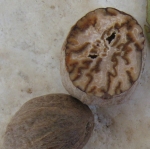The Cooks Illustrated recipe masters recently added nutmeg and orange zest to a pepper-crusted steak to replace two flavorful terpenes, pinene and limonene, lost from black pepper when simmered in oil. In doing so they take advantage of convergent evolution of terpenoids, the most diverse group of chemical products produced by plants. Nutmeg and orange zest, though, were hardly their only options.
The terpene swap
To develop satisfying crunch, the Cooks Illustrated recipe for pepper-crusted beef tenderloin requires a prodigious quantity of coarsely ground black pepper (Piper nigrum; family Piperaceae). If applied to the meat raw, however, in the recipe authors’ view, this heap of pepper generates an unwelcome amount of spicy heat. To mellow it, the recipe authors recommend simmering the pepper in oil and straining it out of the oil before adding it to the dry rub. The hot oil draws out the alkaloid piperine, which makes black pepper taste hot, from the cracked black pepper fruits (peppercorns).
To their dismay, however, the recipe authors discovered that the hot oil also removes flavorful compounds from the cracked pepper, in particular the terpenes pinene and limonene. To rectify this flavor problem, the recipe authors added pinene-rich nutmeg (Myristica fragrans; Myristicaceae) and limonene-rich orange (Citrus x sinensis; Rutaceae) zest to the dry rub, along with the simmered black pepper. In doing so they take advantage of widespread and diverse array of terpenoids in the plant kingdom. Continue reading


